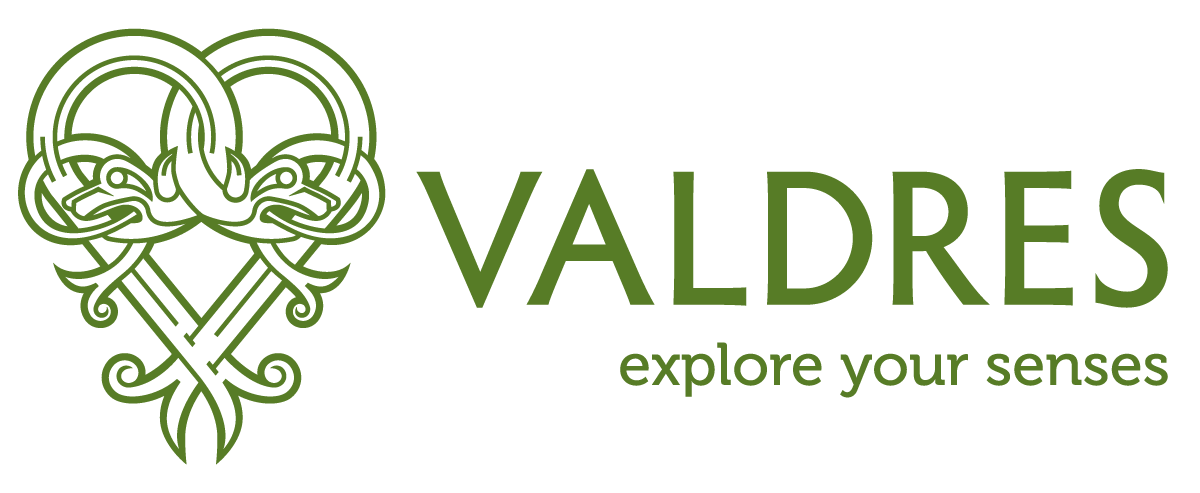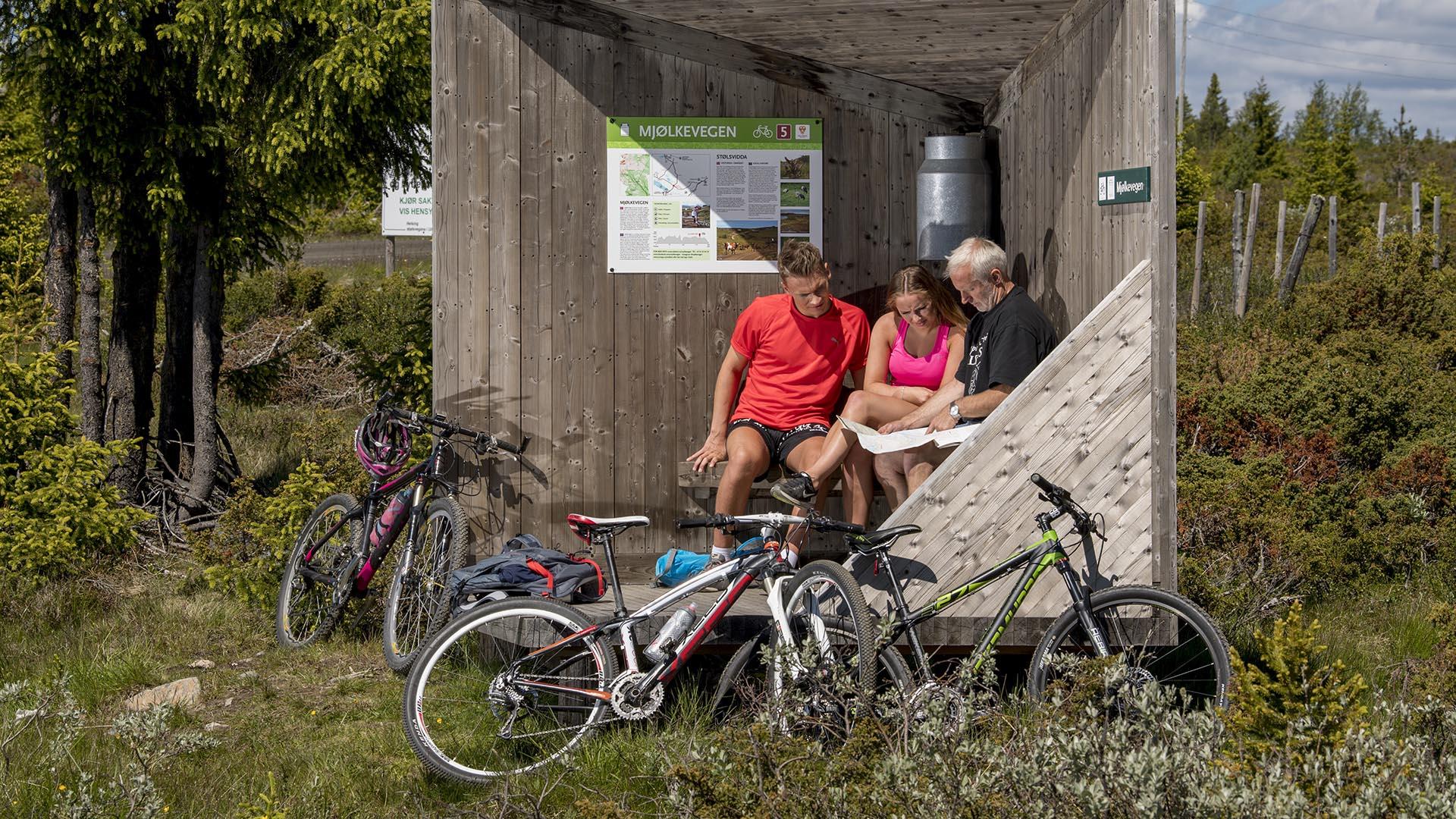Welcome to one of Norway's greates bicycle routes!
Here are answers to the most frequently asked questions about Mjølkevegen. However, if you don't find the information you're looking for, please do not hesitate to contact us at info@visitvaldres.no!
* Mjølkevegen-code:
Inspite of seamingly being close to sivilisation Mjølkevegen offers great natural experiences and phantastic cultural landscape in the farmland areas. It also is an area of rich biodiversity which needs to be protected and maintained for future generations. Thank you for helping in taking care of this natural landscape and contribute to it being preserved as a pristine hideout for locals and visitors alike by
- keeping nature free of waste. In addition to being unpleasant, waste potensially can harm animals. Dispose of your waste at your next accommodation or at marked waste containers along the route. The milk buckets in the Mjølkevegen rest shelters are not waste bins.
- not using nature or private property as a public toilet. It can be far between serviced establishments, but please use these for this kind of need. There's also a pit toilet along Jotunheimvegen, at Raudskaret, between Ruten Fjellstue/Skåbu Fjellhotell and Haugseter Fjellstue.
- giving lifestock and wildlife space and treating them respectfully. It may be very tempting to hold high speed on the superb quality of the gravel roads, but when encountering wildlife and lifestock along the route, riders are required to reduce speed and give them space! The increasing number of cyclists along the route results in increased disturbance to the animals.
- seeing further down for information on how to behave in meeting with cattle and for camping.
* Transport options in and out of the route
By train to Vinstra and back from Gol or vice versa. For this alternative you need to bring your ownbikes, as there is nå bicycle rental at Vinstra for the time being. Tips: There are bookable tour packages that include rental bikes and transport.
By car:
a) Parking at Vinstra or Gol respectively and return by public transport to your car after the finished tour:
- 1) by train via Oslo
- 2) by bus between Gol and Lillehammer (changes at Fagernes and Dokka) and then by train between Lillehammer and Vinstra; www.entur.no og www.vy.no
b) During the period 24. June-18. August you can take the bus from Fagernes or Fagernes or Beitostølen to the alternative starting point Lemonsjø Fjellstue. Mjølkevegen is signed from there; through the Murudalen Valley to Ruten Fjellstue/Skåbu. There are long term parking possibilities (on your own risk) at Fagernes Shell station and at Beitostølen, 300 m from town centre along Beitestølsvegen on your right (against fee).
Valdresekspressen runs from Fagernes and Beitostølen to Gjendesheim, and the local route by Innlandstrafikk from Gjendesheim to Lemonsjø. Return from Golsfjellet/Gol is then on the local route to Fagernes and - if you chose Beitostølen - by either local route or Valdresekspressen to Beitosølen.
If you chose Fagernes, Golsfjellet as the last overnight is within cycling distance. Ask us for the route discription to avoid the main road 51!
* How early/late in the season can I cycle Mjølkevegen?
The southern parts of the Mjølkevegen cycling route should normally be good to cycle already in the end of May; the whole route when the pass road over Slettefjellet opens, approx. in the middle of June.
The season for the route via Tyin follows the boat season on Lake Bygdin (from approx. the end of June to the beginning of September). Dirt roads can be heavy to cycle when wet and soft, but also after new gravel has been applied early during the season. Please bear in mind that the situation can vary from year to year and is dependend on the amount of snow, temperatures and the melting process.
Mjølkevegen over the Slettefjell pass can be cycled until the snow arrives, but some accommodations and eateries can have have reduced opening hours in weekends only or close completely for the season already before the autumn holidays in the beginning of October. Cycling during this season can be very rewarding but also challenging in wet and cold weather. If you have not booked a cycling package, please check ahead and make reservations or be prepared to manage on your own.
* Road standard: What kind of roads does one cycle on?
In general, there are mostly gravel roads along the route. Mountain and farm roads with limited motorized traffic. However, in some areas, the gravel roads and trails can get soft and muddy, especially after snow melting (early in the season) and after heavy rain. Also, early in the season, some roads get a new layer of loose gravel, making it a bit more challenging to cycle on.
There are some trail sections where you have to be prepared to push your bike. Examples are along the King's Road between Tyinkrysset and Øye, 2 km between Viksyndin and Nørdre Trøllhøvd, along the cross-counrtry skiing tracks up to Storefjell and partly over Golsfjellet. The asphalt sections are from Vinstra a bit uphill before you hit the mountain roads to Fefor, along road 51 between Bygdin via Beitostølen to Lykkja at the start of the Slettefjellvegen road, from Høre via Ryfoss until a bit uphill to where the mountain road to Syndinstøga starts and in the end from the western side of Golsfjellet down to Gol.
* Trailer: Can I cycle Mjølkevegen with a trailer/trolley?
It is possible to cycle Mjølkevegen with a trailer/trolley, but you would have to take detours around the trail sections (see above). Contact us for more details.
* On tour with an e-bike; what do I have to consider and where can I recharge my batteries?
Running out of power is the biggest hassle with e-bikes, but the key is good planning. The longest uphill sections that can drain batteries quickly are from Ruten to the highest point along Jotunheimvegen (the saddle close to Buhøa), the mountain pass over Slettefjellet, and the climb from Ryfoss to Syndinstøga. On those stretches, please use your "e" with care and as a supplement only. If coming from Tyin, instead of Slettefjell, beware of a longer climb from Lake Vangsmjøse and up to to Hensåsen.
Charging stations along the route are:
- The Filefjell Tourist office/Intersport store at Tyinkrysset - inside or, if closed, outside on the wall close to the garbage containers. You may borrow Shimano, Bosch and Yamaha chargers
- The Beitostølen Tourist office at Velkomstsenteret in the centre of Beitostølen
- Slettefjellkiosken: 6 contacts for charging of e-bikes against fee
- At Gol: In the tourist office and at the Tesla charging station along road 7
- At all Mjølkevegen-accommodations along the route for guests
* How should I behave if I encounter cattle on my cycling tour?
The Mjølkevegen cycling route leads through the largest area in the country with actively run mountain farms. Free grazing lifestock can be encountered almost anywhere along the route; sheep, goats and cattle. If you encounter a free grazing herd of cattle we recommend following the “cattle code”, given by the organisations Norsk Friluftsliv, Norges Bondelag and Tine, a.o. We sum up the cattle code here:
- Dismount your bike. Keep a distance to the animals and go around the herd.
- Don't go inbetween the animals. Cattle are inquisitive and can be obtrusive. They can create unwanted situations.
- Don't approach calves. Mother cows are very protective and can charge.
- Dogs should not be taken near cattle. If you cycle Mjølkevegen with a dog, keep it on a leash at all times until 20. August (general period when dogs must be leashed). Some municipatilties can have a prolonged leash period until October.
- Cattle are inquisitive. If they become obtrusive, put down your bicycle and retreat calmly. Wait until the herd has moved on before you return to your bike and continue your cycling tour.
- If you pass through gates, remember to close them behind you in order to avoid giving the animals access to areas where they are not supposed to be.
* Can I sleep in a tent along Mjølkevegen?
Mjølkevegen is not recommended as a free camping route. There are great roofed accommodations, offering riders a good bed for the night and delicious, often regional, food as well as other amenities like washing stations, dryings rooms, locked bike storage and power outlets for charging. If you still want to pitch a tent, we ask that you use the camp grounds along the route:
- Randsverk Camping at the alternative start/exit at Lemonsjø
- Arctic domes at Bygdin Fjellhotell
- Beitostølen Hytter og Camping
- Rogn Camping
- Vaset Camping
- First Camp Gol
If you are exiting towards Fagernes instead of Gol, there are camp grounds found in Tisleidalen (Bjørkestølen Helårscamping, Vasetdansen Camping), Leira (Strandheim Hyttetun og Valdres Camping) and Fagernes (Fagernes Camping).
Mjølkevegen differs from other popular biking routes in leading through vast, private and active mountain farming land which on one hand contributes greatly to the route's attractivenes but on the other hand demands special consideration and respect from cyclists. Free camping creates not only pollution but may hold risks as well. There are free roaming sheep, goats and cattle in the whole area. Especially cattle are large, inquisitive and can be obtrusive. They like to flock around tents, lick on them and can stamp them. Cattle can tur up out of nowhere basically anywhere along the route.
Water from lakes, rivers and streams along the route should not be consumed untreated.
* Can I drive the route with a motorbike?
Mjølkevegen is a cycling tour but leads mainly along roads that are open to motorized traffic. It is therefore possible to drive along the route, with a few exceptions where detours are necessary. This applies mainly to the trail sections between Viksyndin and Trollhøvd and on Golsfjellet. Also, with a motor bike you need to take the the route over Slettefjellet, as the boat on Lake Bydin is a passenger service only. Please drive responsibly and mind cyclists and animals along the road.
* Can I drive the route with a camper?
See the topic above. It is possible to drive along Mjølkevegen with a motorized vehicle with a few exceptions where detours are necessary. Also, there very limited possibilities to park your vehicle since the route leads through actively used farm and grazing lands. We recommend the campgrounds at Beitostølen, near Ryfoss (detour of 6 km along road E16) and at Vaset. Please drive resposibly and mind cyclists and animals along the road.
For overnights, please see above for a list of camp grounds along the route.
* Are there tour packages for Mjølkevegen that I can book?
We have created an overview over tour packages along the route that are available for booking. Here all your needs are taken care of and included - transport in and out of the route, bicycle rental, accommodation, meals, baggae transport, tour descriptions and GPS-files for the seperate legs. You can choose packages from different parts of the route, as well; the northern part, the southern part and special weekend-/family tour packages.
* Packing list:
The highest point of the route is at 1300 m.a.s.l. where the climate can change from friendly to rough and the weather is prone to sudden changes. In order to maintain the joy of cycling, it is essential that you have packed right.
- Long underwear and wind proof outer layer on your legs and body. Light down jacket for fast downhills, as well as a thin hat beneath your helmet and a pair of gloves. But just as well short-legged cycling pants and a T-shirt. Swimwear and a small towel for a dip along the road.
- There can be potholes, longitudinal cracks and bumps in the roads, especially early in the season after frost damages, and just like that you've rolled over. Always wear a helmet!
- If you cycle unsupported without baggage transport, use water proof bags or rain cover.
- It can be far until the next accommodation and even further to a medical doctor. Bring a basic first aid kit.
- Bring good shoes, either water proof shoes or water proof shoe covers.
- Always have a little ekstra energy easily available, such as an energy bar or some chocolate, and a warm drink in your thermos bottle. When exhausted, syrup or tea taste better than water.
- Bring water bottles and fill them up at your accommodation. Since cycling through farm land, water from streams or lakes should not be consumed untreated.
- A basic repair kit a with spare tube, extra break and a pump is always wise to have along remote gravel roads, even with a rental bike. There are great distances and it can take some time until help arrives.
- When using an e-bike, remember your charger. With a rental e-bike, learn how to use it.








Follow us on Facebook
Follow us on Instagram